Investigations into the fire revealed a troubling lack of safety protocols in the warehouses and caravanserais. Flammable materials had been stored with little regard for fire hazards, and fire prevention equipment was either outdated or nonexistent. The worker whose negligence had sparked the fire was reportedly inexperienced and unsupervised at the time of the incident. His identity became a subject of intense scrutiny in the media, and he was ultimately held accountable, though the broader system failures were equally to blame.
In the weeks and months that followed, the fire became a catalyst for change in Tehran. Public outrage over the incident prompted government officials to reassess the city’s emergency preparedness and industrial safety regulations. Fire codes were revised, and new guidelines were implemented for the storage of flammable goods. Regular inspections of warehouses became mandatory, and fire drills were introduced in public institutions and large businesses.
The disaster also highlighted the need for a more modern and better-equipped fire department. Funds were allocated to purchase new firefighting equipment, improve training programs, and establish additional fire stations throughout the city. Plans were made to develop an early warning system and communication network that could expedite the response time in future emergencies.
Despite these improvements, the scars of the 1955 fire remained. For those who lost loved ones, homes, or businesses, the pain lingered long after the smoke had cleared. Community leaders organized relief efforts to provide food, clothing, and shelter to those affected. Charitable organizations stepped in to assist families in rebuilding their lives, while the government offered financial aid and low-interest loans to business owners looking to restart their operations.

